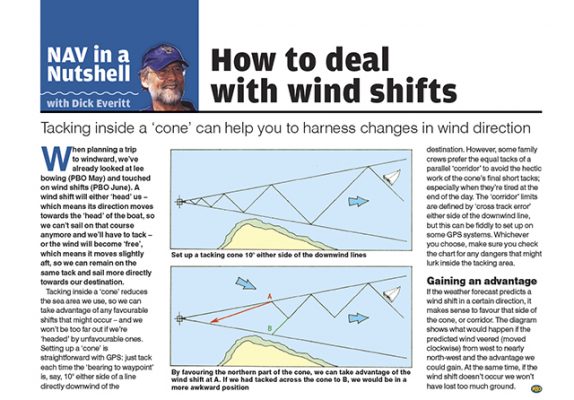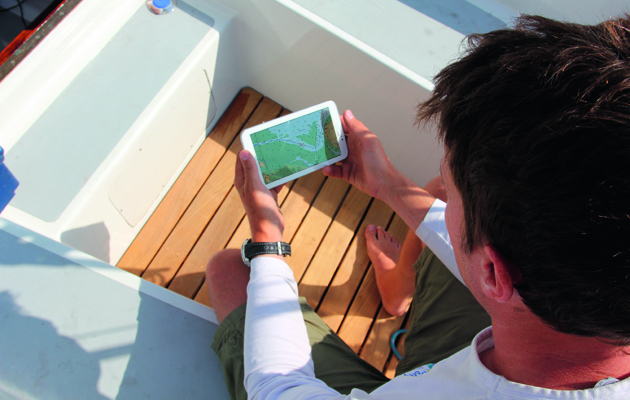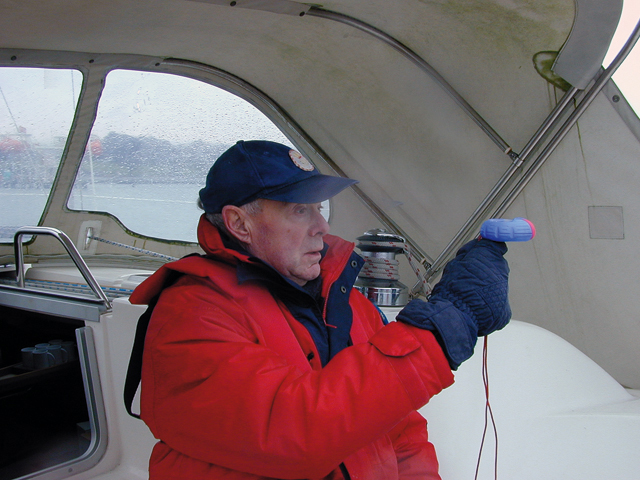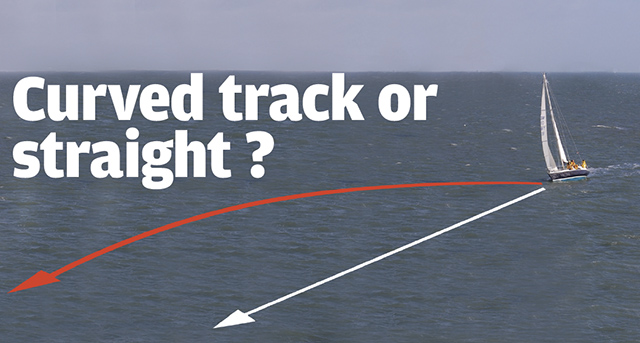Tacking inside a ‘cone’ can help you to harness changes in wind direction, explains Dick Everitt.
When planning a trip to windward, we’ve already looked at lee bowing and touched on wind shifts.
A wind shift will either ‘head’ us – which means its direction moves towards the ‘head’ of the boat, so we can’t sail on that course anymore and we’ll have to tack – or the wind will become ‘free’, which means it moves slightly aft, so we can remain on the same tack and sail more directly towards our destination.
Tacking inside a ‘cone’ reduces the sea area we use, so we can take advantage of any favourable shifts that might occur – and we won’t be too far out if we’re ‘headed’ by unfavourable ones.
Setting up a ‘cone’ is straightforward with GPS: just tack each time the ‘bearing to waypoint’ is, say, 10° either side of a line directly downwind of the destination. However, some family crews prefer the equal tacks of a parallel ‘corridor’ to avoid the hectic work of the cone’s final short tacks; especially when they’re tired at the end of the day.
The ‘corridor’ limits are defined by ‘cross track error’ either side of the downwind line, but this can be fiddly to set up on some GPS systems. Whichever you choose, make sure you check the chart for any dangers that might lurk inside the tacking area.

Gaining an advantage
If the weather forecast predicts a wind shift in a certain direction, it makes sense to favour that side of the cone, or corridor. The diagram shows what would happen if the predicted wind veered (moved clockwise) from west to nearly north-west and the advantage we could gain.
At the same time, if the wind shift doesn’t occur we won’t have lost too much ground.
This Nav in a Nutshell was published in the July 2012 issue of PBO. For more useful archive articles explore the PBO Copy Service.
A handy guide to using traditional skills for navigation
PBO contributor Sticky Stapylton shows how to work out an estimated position and course to steer
14 iPad and Android navigation apps tested
Gear test following an explosion in the number of marine navigation apps available for iPad and Android devices in the…
Nav in a Nutshell: Clearing bearings
In the first of his series on back-to-basics navigation Dick Everitt explains how to use a few simple lines to…
Nav in a Nutshell: What is a transit and how are they used in navigation
Lining up a pair of appropriate land features or navigation marks can help keep you safe, as Dick Everitt explains
Nav in a Nutshell: Navigate by ‘feel’ using an echo sounder
The ‘ping’ is king: You can navigate by ‘feel’ over the seabed in adverse conditions by using an echo sounder…
Nav in a Nutshell: Lighthouse characteristics on charts
Dick Everitt helps illuminate our understanding of lighthouse characteristics on charts, their dipping distances and loom...
Nav in a nutshell: Navigating at night
There’s no need to be in the dark if your preparation is thorough and easy to understand, says Dick Everitt…
Nav in a nutshell: Navigate with radar
Dick Everitt gives us a clear picture of the advantages to be gained from using radar to check our navigation
Nav in a nutshell: Looks good on paper
Up-to-date printed paper charts are a good bet for identifying your position – but they do have their limits, says…
Nav in a nutshell: Electronic charts
Dick Everitt assesses the differences between raster and vector charts when deciding on which chart plotter to buy
Nav in a nutshell: Coping with currents
Dick Everitt explains how sailors can apply knowledge of tidal streams to ensure that water flow is a help, not…
Nav in a nutshell: Know tidal vectors
'It’s easy for any sailor to remember how to draw tidal vectors with a handy little aide-mémoire!' Says Dick Everitt.…
Nav in a nutshell: Shaping a course
GPS is not infallible, so it makes sense to know the basics of shaping a rough ‘course to steer’ on…
Nav in a nutshell: How to use a Breton Plotter
Breton Plotters are simple to use in practice, but tricky to explain on paper – it’s much easier if you…
Nav in a nutshell: Curved track or straight?
GPS will keep us on the straight and narrow by constantly showing how much we need to adjust our heading…
Tablet navigation – mount it safely
Why not mount it on the washboards?
Nav in a nutshell: Tacking to clear a headland
Simple step-by-step chartwork can show us when we’ll need to tack to clear a headland, says Dick Everitt.
Nav in a nutshell: Lee bowing defined
Dick Everitt explains how you can get a little lift from the tide
Nav in a nutshell: Making comfortable progress to windward
Why make heavy going in choppy conditions when a less demanding alternative heading will get you to your destination in…























